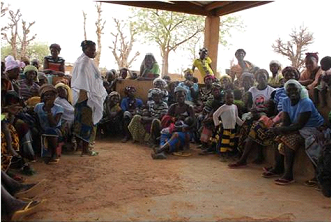Adaptation processes in agriculture and food security: Insights from evaluating behavioral changes in West Africa
Hello, my name is Jacques Somda, and I would like to share a blog with you about the paper I intend to present at the 2nd International Conference on Evaluating Climate Change and Development. This paper focuses on evaluating the adaptive capacities in human systems in relation with agriculture and food security at the community level in West African countries. It aims to highlight approaches and domains of monitoring and evaluation (M&E) of behavioral changes which can be used to formulate adaptive capacity indicators. The study was conducted through the CGIAR's research program on Climate Change, Agriculture and Food Security (CCAF) implemented in five countries in West Africa. This program is implementing participatory action research on 'climate-smart agriculture' for smallholder farming systems.
Adaptation refers to both process and condition
The Intergovernmental Panel on Climate Change summarized the use of a major explanatory variable 'adaptive capacity' underlying adaptation to climate change and determining its efficacy. It described adaptive capacity as the potential or ability of a system, region, or community to adapt to the effects or impacts of climate change, and adaptation as adjustments in ecological, social, or economic systems in response to actual or expected climatic stimuli and their effects or impacts. As such, adaptation refers both to the process of adapting and to the condition of being adapted. Yet, current adaptation M&E has put more emphasis on condition than process, leading to development outcomes mistaken for adaptation. To avoid such confusion, it is important to improve M&E of the adaptation process.
Why is behavioral change important in M&E of adaptation processes?
Behavioral change theory has become an important factor in determining the propensity or ability of a community to adapt, and in understanding how adaptation conditions are constructed within a community. Determinants of adaptive capacity include economic, social, institutional, and technological conditions that facilitate or constrain development and deployment of adaptive measures. Therefore identifying ?adaptive? behavioral changes helps distinguish adaptation outcomes from development outcomes, and improves understanding of linkages between the two.
What types of behavioral changes can be observed and documented from adaptation activities, and how?

Photo: Women?s group planning for behavioral changes
(Tibtenga, Burkina Faso, 2012).
Various types of behavioral changes can be observed in community life. It may not be practical to anticipate the attributes of behavioral change that could occur from adaptation interventions. However, one could plan for the domains or conditions of community life where changes in behavior are expected if the adaptation interventions are successful. Such a planning exercise should include the community members and all stakeholders. Then, using outcome harvesting methods such as the 'most significant change' technique, stories of change can be collected and analyzed qualitatively and quantitatively to identify the attributes of behavioral change put in place in a community. This is what CCAFS's partners have applied in West African countries. Results indicate that participatory action research on climate-smart agriculture contributed to farmers? behavioral changes in five domains, namely knowledge, practices, access to assets, partnership and organization.
How can behavioral change improve adaptation M&E?
Once behavioral changes have been identified, they can then be attributed to particular domains or conditions of community life. These ?adaptive? behaviors can then be used to refine adaptation outcomes and indicators. In doing so, changes in adaptation conditions are consistently identified for monitoring and evaluating the adaptation intervention. In the case of the CCAFS programme in West Africa, use of the behavioral change approach suggests that the programme has contributed to five conditions or domains of community life, and the following indicators can be used for each adaptation condition:
- % increase of farmers knowledgeable on climate change and climate-smart agricultural technologies,
- % increase of farmland size with climate-smart agricultural technologies and % increase adoption rate of climate-smart technologies,
- % increase of farmers access to assets,
- % increase of farmers entering into partnership arrangements, and
- % increase of farmers entering community-based organizations.
Although adaptation is context-specific, using the behavioral change approach to elucidate the adaptation processes provides insights for identifying comparable indicators across communities, at least at the adaptation conditions level.
The application of the behavioral changes approach to the participatory action research of the CCAFS programme in West Africa has highlighted the similarities and differences between men and women in undergoing ?adaptive? behavioral changes. Issues that can lead to mal-adaptation can also be identified and dealt with to maintain the initiated ?adaptive? behavioral changes. At times, individual community members who initiated changes in behavior may face additional unanticipated challenges that reverse the change and make the individual return to his or her previous behavior. Overall, results suggest that behavioral changes theory provides valuable insights on how to maintain the initiated changes in behavior. This information constitutes an important source of learning within adaptation M&E.
Please post any questions or comments you may have below.




